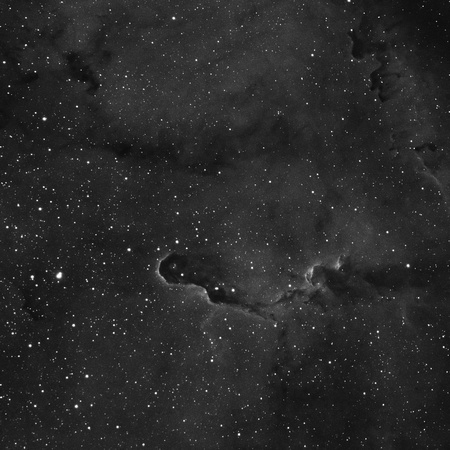SBIG ST-4000XCM4x1800sec (2 Hours)Darks/Flats/Bias AppliedImager Temp -10CAPM/TMB 130/780Field Flattener
Baader 7nm H alpha filter
Red Channel Only
Full Frame
Link to medium large JPEGImaged during a waning gibbous moon
Also known as
van den Bergh 142, these two "sub"nebulae are part of, and argueably the most interesting feature of the huge IC1396 complex in Cepheus.
IC1396A is the "Elephant's Trunk" Nebula, and is the left part of the nebula with the "eye" in the end, and IC1396B is the right part of the nebula coming in from the right of the frame.
THe Elephant's Trunk Nebula winds through the emission nebula and young star cluster
complex IC 1396, in the constellation
Cepheus. The nebula is over 20 light-years long and nearly 3000
light-years distant.
The bright rim is the surface of the dense cloud of IC 1396A that is being illuminated and ionized by a very bright, massive star that is just to the west of IC 1396A. (In the Figure above, the massive star is just to the left of the edge of the image.) The entire
IC 1396 region is ionized by the massive star, except for dense globules that can protect themselves from the star's harsh ultraviolet rays.
The Elephant Trunk nebula is now thought to be site of star formation, containing several very young (less than 100,000 yr) stars. Two older stars (but still young, a couple of million years) are present in a small, circular cavity in the head of the globule. Winds from these young stars may have emptied the cavity.
The combined action of the light from the massive star ionizing and compressing the rim of the cloud, and the wind from the young stars shifting gas from the center outward lead to very high compression in the Elephant Trunk nebula. This pressure has triggered the current generation of protostars.
July 13, 2009


